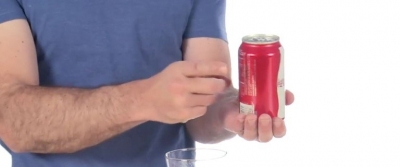
What you need:
Two unopened soda cans (club soda or flavoured, both will do: do not use diet sodas), a sink
What to do:
1. Pick up the first can. Shake it vigorously.
2. Hold it over the sink and snap it open. What happens?
3. Take the second can and shake that vigorously too.
4. Now, hold it in the palm of one hand, and using your index finger, tap or flick the can on all sides. Make sure you cover all the walls.
5. Now, open the can.
What happens:
On being opened, the first can swooshes up most of its contents in a foamy fountain. When the second can is opened, after it has been tapped on all sides, there is no foaming. You can actually enjoy the whole soda!
Why?
The fizz in the soda is actually carbon dioxide gas. When cold drinks are manufactured, a lot of carbon dioxide is dissolved in the liquid much more than the liquid can hold at normal atmospheric pressure (that is why cold drinks are also called ‘carbonated’ drinks). To do so, a large amount of pressure is applied.
When you open a can of soda, some of the carbon dioxide gas escapes but enough remains in the liquid so you get a fizzy taste. This carbon dioxide is visible in the form of bubbles.
When you shake a sealed can of soda, the carbon dioxide bubbles settle on the inner walls of the can. When you open this can you release the pressure inside. That means, the pressure of the can’s contents falls rapidly. There is a relationship between the pressure of a gas and its volume (the number of particles/molecules packed in a small space): it was discovered by a scientist named Robert Boyle and is known as Boyle’s law. According to this law, at a constant temperature, when the pressure of a gas decreases, its volume increases, and vice-versa.
So, when the pressure of the gas in the can falls, its volume suddenly increases and the bubbles multiply and swooosh! From the walls of the can the bubbles rapidly try to get to its mouth to escape. They push the liquid out too because it is in their way. That’s how you get sprayed. That is why, after shaking the can, you need to tap sides. This helps dislodge the carbon dioxide bubbles from the can’s walls. Once dislodged, they settle on the top of the liquid (because a gas is usually lighter than a liquid). That way, when you open the can, the carbon dioxide escapes comfortably. There is no liquid obstructing its way which means clean clothes for us, yay!
Picture Credit : Google




